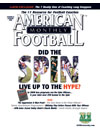AMERICAN FOOTBALL MONTHLY THE #1 RESOURCE FOR FOOTBALL COACHES
Article CategoriesAFM Magazine
|
Did the Spin Offense Live Up to its Hype?With over 250 High Schools implementing the spin offense, AFM profiled 3 programs...by: Mike Kuchar © More from this issue If you were to ask Cirtronelle High School (AL) Offensive Coordinator Barry Gibson or Catholic High’s (LA) Head Coach Dale Weiner a year ago if they thought they would have this much feedback from the Spin offense, neither one would have believed you. But the truth is since the first article on the Spin appeared in AFM’s December, 2006 issue, Gibson and Weiner have spent countless hours on the computer emailing coaches and in the post office sending out cut-ups of the Spin scheme. It has taken off literally to the point where the distribution process has become a second job. “I’m thinking about hiring someone just to take phone calls and do all the shipping of these tapes,” said Weiner. “The response since the article came out has been nothing short of miraculous. It’s even been overwhelming at times.” Weiner put....The full article can only be seen by subscribers. Subscribe today!
|
|
|||||||
| HOME |
MAGAZINE |
SUBSCRIBE | ONLINE COLUMNISTS | COACHING VIDEOS |
Copyright 2025, AmericanFootballMonthly.com
All Rights Reserved





